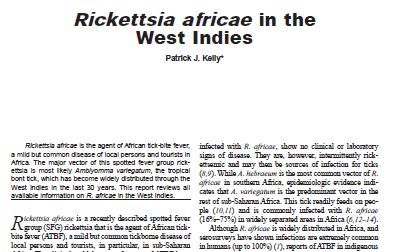 Rickettsia africae is a recently described spotted fever group (SFG) rickettsia that is the agent of African tickbite fever (ATBF), a mild but common tickborne disease of local persons and tourists, in particular, in sub-Saharan Africa. The clinical and laboratory features of ATBF have recently been reviewed (1), as has the diagnosis of the disease (2). In Africa, the tropical bont tick, Amblyomma variegatum, is commonly infected with R. africae and is likely the major vector of the organism (3). This tick was introduced from Africa (Senegal) into the West Indies (Guadeloupe) in the early 1800s but has only spread widely and become endemic on many islands in the last 30 years (4). This spread was probably due to an increase in the between-island movement of livestock, major hosts of A. variegatum (5), and the introduction and spread of the cattle egret (Bubulcus ibis), a host of the immature stages of A. variegatum (5). Recent studies have demonstrated R. africae infections in A. variegatum, persons, and animals in the West Indies. In this report, the available information on R. africae in the region is reviewed.
Rickettsia africae is a recently described spotted fever group (SFG) rickettsia that is the agent of African tickbite fever (ATBF), a mild but common tickborne disease of local persons and tourists, in particular, in sub-Saharan Africa. The clinical and laboratory features of ATBF have recently been reviewed (1), as has the diagnosis of the disease (2). In Africa, the tropical bont tick, Amblyomma variegatum, is commonly infected with R. africae and is likely the major vector of the organism (3). This tick was introduced from Africa (Senegal) into the West Indies (Guadeloupe) in the early 1800s but has only spread widely and become endemic on many islands in the last 30 years (4). This spread was probably due to an increase in the between-island movement of livestock, major hosts of A. variegatum (5), and the introduction and spread of the cattle egret (Bubulcus ibis), a host of the immature stages of A. variegatum (5). Recent studies have demonstrated R. africae infections in A. variegatum, persons, and animals in the West Indies. In this report, the available information on R. africae in the region is reviewed.
Read full article in PDF: Rickettsia Africae in Amblyomma final paper (PDF)
More information: R. africae in the WI (PDF)